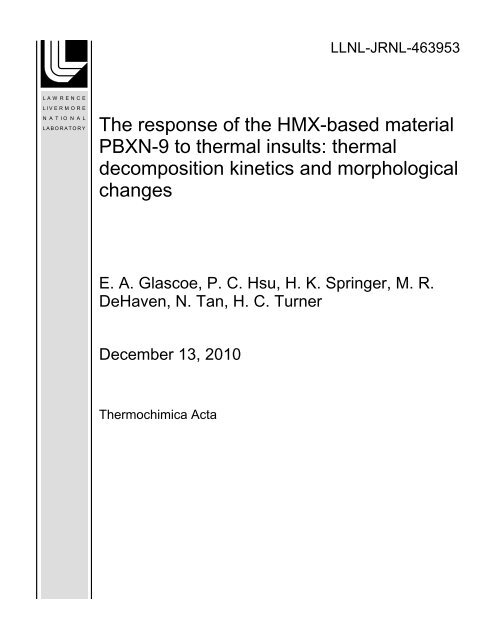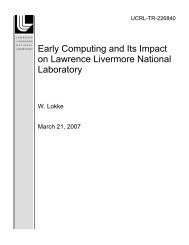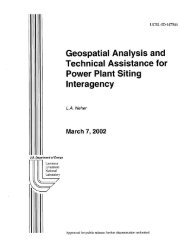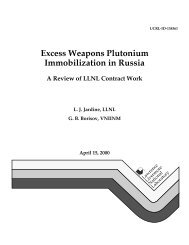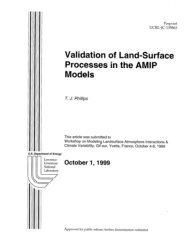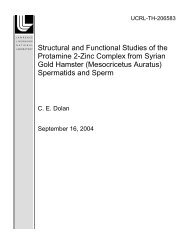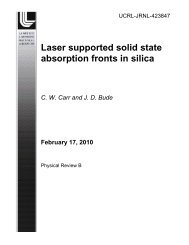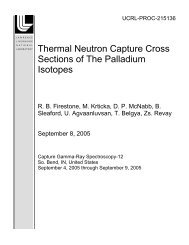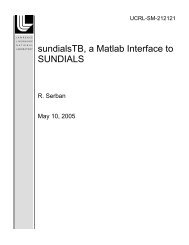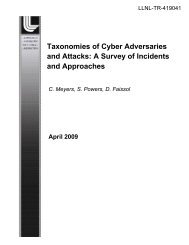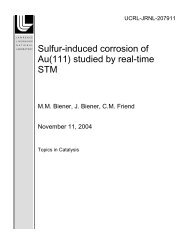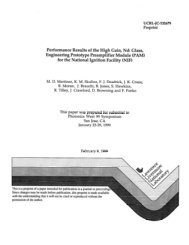The response of the HMX-based material PBXN-9 to thermal insults ...
The response of the HMX-based material PBXN-9 to thermal insults ...
The response of the HMX-based material PBXN-9 to thermal insults ...
Create successful ePaper yourself
Turn your PDF publications into a flip-book with our unique Google optimized e-Paper software.
LLNL-JRNL-463953<br />
<strong>The</strong> <strong>response</strong> <strong>of</strong> <strong>the</strong> <strong>HMX</strong>-<strong>based</strong> <strong>material</strong><br />
<strong>PBXN</strong>-9 <strong>to</strong> <strong>the</strong>rmal <strong>insults</strong>: <strong>the</strong>rmal<br />
decomposition kinetics and morphological<br />
changes<br />
E. A. Glascoe, P. C. Hsu, H. K. Springer, M. R.<br />
DeHaven, N. Tan, H. C. Turner<br />
December 13, 2010<br />
<strong>The</strong>rmochimica Acta
Disclaimer<br />
This document was prepared as an account <strong>of</strong> work sponsored by an agency <strong>of</strong> <strong>the</strong> United States<br />
government. Nei<strong>the</strong>r <strong>the</strong> United States government nor Lawrence Livermore National Security, LLC,<br />
nor any <strong>of</strong> <strong>the</strong>ir employees makes any warranty, expressed or implied, or assumes any legal liability or<br />
responsibility for <strong>the</strong> accuracy, completeness, or usefulness <strong>of</strong> any information, apparatus, product, or<br />
process disclosed, or represents that its use would not infringe privately owned rights. Reference herein<br />
<strong>to</strong> any specific commercial product, process, or service by trade name, trademark, manufacturer, or<br />
o<strong>the</strong>rwise does not necessarily constitute or imply its endorsement, recommendation, or favoring by <strong>the</strong><br />
United States government or Lawrence Livermore National Security, LLC. <strong>The</strong> views and opinions <strong>of</strong><br />
authors expressed herein do not necessarily state or reflect those <strong>of</strong> <strong>the</strong> United States government or<br />
Lawrence Livermore National Security, LLC, and shall not be used for advertising or product<br />
endorsement purposes.
<strong>The</strong> <strong>response</strong> <strong>of</strong> <strong>the</strong> <strong>HMX</strong>-<strong>based</strong> <strong>material</strong> <strong>PBXN</strong>-9 <strong>to</strong> <strong>the</strong>rmal <strong>insults</strong>: <strong>the</strong>rmal<br />
decomposition kinetics and morphological changes<br />
Elizabeth A. Glascoe a* , Peter C. Hsu a , H. Keo Springer a , Martin R. DeHaven a , Noel Tan a , Heidi C. Turner a<br />
a Energetic Materials Center, Lawrence Livermore National Labora<strong>to</strong>ry, 7000 East Avenue, Livermore, CA 94550<br />
*Corresponding Author. Tel.: +1 925 424 5194; fax: +1 925 424 3281; E-mail address: glascoe2@llnl.gov<br />
Abstract<br />
<strong>PBXN</strong>-9, an <strong>HMX</strong>-formulation, is <strong>the</strong>rmally damaged and <strong>the</strong>rmally decomposed in order <strong>to</strong> determine <strong>the</strong><br />
morphological changes and decomposition kinetics that occur in <strong>the</strong> <strong>material</strong> after mild <strong>to</strong> moderate heating. <strong>The</strong><br />
<strong>material</strong> and its constituents were decomposed using standard <strong>the</strong>rmal analysis techniques (DSC and TGA) and <strong>the</strong><br />
decomposition kinetics are reported using different kinetic models. Pressed parts and prill were <strong>the</strong>rmally damaged,<br />
i.e. heated <strong>to</strong> temperatures that resulted in <strong>material</strong> changes but did not result in significant decomposition or<br />
explosion, and analyzed. In general, <strong>the</strong> <strong>the</strong>rmally damaged samples showed a significant increase in porosity and<br />
decrease in density and a small amount <strong>of</strong> weight loss. <strong>The</strong>se <strong>PBXN</strong>-9 samples appear <strong>to</strong> sustain more <strong>the</strong>rmal<br />
damage than similar <strong>HMX</strong>-Vi<strong>to</strong>n A formulations and <strong>the</strong> most likely reasons are <strong>the</strong> decomposition/evaporation <strong>of</strong> a<br />
volatile plasticizer and a polymorphic transition <strong>of</strong> <strong>the</strong> <strong>HMX</strong> from <strong>to</strong> phase.<br />
Keywords<br />
<strong>The</strong>rmal damage, <strong>the</strong>rmal decomposition, kinetics, <strong>HMX</strong>, <strong>PBXN</strong>-9<br />
1. Introduction<br />
A thorough understanding <strong>of</strong> <strong>the</strong> <strong>response</strong> <strong>of</strong> energetic <strong>material</strong>s <strong>to</strong> heat is <strong>of</strong> broad interest <strong>to</strong> <strong>the</strong> explosives<br />
and propellants communities. <strong>The</strong> development <strong>of</strong> safe handling and s<strong>to</strong>rage methods requires a detailed<br />
understanding <strong>of</strong> how a <strong>material</strong> changes when exposed <strong>to</strong> heat. Mild heating <strong>of</strong> an explosive may produce<br />
morphological and/or compositional changes that may alter <strong>the</strong> microstructure and increase <strong>material</strong> surface area<br />
due <strong>to</strong> <strong>the</strong> introduction <strong>of</strong> voids and pores. <strong>The</strong>se changes can affect <strong>the</strong> <strong>material</strong> properties such as sensitivity,<br />
safety, and performance; hence handling and reusing a damaged explosive requires careful consideration. A prior<br />
knowledge <strong>of</strong> how <strong>the</strong> <strong>material</strong> behaves when heated would allow workers <strong>to</strong> make more informed decisions about<br />
how <strong>to</strong> deal with a <strong>the</strong>rmally damaged <strong>material</strong>. In addition, a basic understanding <strong>of</strong> <strong>the</strong>rmally induced changes<br />
assists in <strong>the</strong> interpretation <strong>of</strong> more complex experiments such as deflagration, shock and/or impact initiation<br />
experiments, and <strong>the</strong>rmal explosions. Finally, quantitative characterization <strong>of</strong> <strong>material</strong>s after mild heating and<br />
development <strong>of</strong> decomposition kinetic models provides <strong>the</strong> data necessary <strong>to</strong> develop and/or parameterize<br />
computational models used <strong>to</strong> predict phenomenon such as <strong>the</strong>rmal explosion, shock or impact initiation, sample<br />
deflagration, etc.<br />
<strong>The</strong> kinetics and mechanisms <strong>of</strong> <strong>the</strong>rmal decomposition <strong>of</strong> energetic <strong>material</strong>s are particularly important <strong>to</strong> <strong>the</strong><br />
study <strong>of</strong> <strong>the</strong>rmal explosions (e.g. cook-<strong>of</strong>f). A <strong>material</strong> might explode if it is exposed <strong>to</strong> a stimulus sufficient <strong>to</strong><br />
initiate significant <strong>material</strong> decomposition, typically <strong>the</strong> stimulus is heat. In most slow cook-<strong>of</strong>f scenarios, <strong>the</strong> first<br />
step is molecular-level decomposition via a mechanism that begins with one or more endo<strong>the</strong>rmic and/or exo<strong>the</strong>rmic<br />
reactions. <strong>The</strong> decomposition is accelerated by au<strong>to</strong>catalytic chemical reactions and <strong>the</strong> energy released due <strong>to</strong><br />
exo<strong>the</strong>rmic reactions. Eventually <strong>the</strong> <strong>material</strong> begins <strong>to</strong> deflagrate (i.e. burn) and consumption <strong>of</strong> <strong>the</strong> <strong>material</strong><br />
accelerates. Some <strong>material</strong>s shift from deflagration <strong>to</strong> de<strong>to</strong>nation (DDT), yet even <strong>material</strong>s that do not undergo<br />
DDT can react quite violently, as has been observed in one-dimensional-time-<strong>to</strong>-explosion (ODTX) and scaled<strong>the</strong>rmal-explosion<br />
(STEX) experiments [1, 2].<br />
<strong>The</strong> energetic <strong>material</strong> <strong>HMX</strong> (octahydro-1,3,5,7-tetranitro-1,3,5,7-tetrazocine) is a common molecule used in a<br />
variety <strong>of</strong> different explosives; consequently, <strong>the</strong>re is a considerable volume <strong>of</strong> literature investigating <strong>the</strong> <strong>response</strong><br />
<strong>of</strong> <strong>HMX</strong> <strong>based</strong> <strong>material</strong>s <strong>to</strong> heat [3-8]. At approximately 160 °C, <strong>HMX</strong> experiences a polymorphic transition, from<br />
<strong>the</strong> - <strong>to</strong> <strong>the</strong> -polymorph [8]. Because <strong>the</strong> -polymorph is approximately 7% larger in volume <strong>the</strong> explosive charge<br />
may experience irreversible volume expansion and a significant increase in sample porosity due <strong>to</strong> irreversible<br />
rearrangement <strong>of</strong> <strong>the</strong> crystal-binder packing [9]. <strong>The</strong>se changes in morphology can change <strong>the</strong> performance <strong>of</strong> <strong>the</strong><br />
LLNL-JRNL-463953<br />
Released for public Audience<br />
Published in <strong>The</strong>rmochimica Acta, 515 (2011) 58-66.
explosive charge. Previous studies demonstrate that both gas permeabilities and burn rates <strong>of</strong> <strong>the</strong> damaged LX-04<br />
samples (85% <strong>HMX</strong>, 15% Vi<strong>to</strong>n A) increased by several orders <strong>of</strong> magnitude [7, 10]. Urtiew et. al reported that<br />
heated LX-04 was more sensitive <strong>to</strong> shock initiation at high temperatures [11]. Hsu et al. reported that both<br />
de<strong>to</strong>nation velocity and de<strong>to</strong>nation energy density <strong>of</strong> <strong>the</strong>rmally damaged LX-04 were significantly lower than those<br />
<strong>of</strong> pristine high-density LX-04 [12].<br />
<strong>The</strong> <strong>material</strong> <strong>PBXN</strong>-9 consists <strong>of</strong> <strong>the</strong> energetic <strong>material</strong> <strong>HMX</strong>, <strong>the</strong> plasticizer dioctyl adipate (DOA), and a<br />
polyacrylate elas<strong>to</strong>mer binder (HYTEMP 4454). <strong>HMX</strong> <strong>based</strong> <strong>material</strong>s have been studied extensively, however,<br />
many <strong>of</strong> <strong>the</strong> studies have focused on <strong>material</strong>s with inert binders (i.e. Vi<strong>to</strong>n A, hereafter referred <strong>to</strong> simply as Vi<strong>to</strong>n)<br />
[7, 10]. In contrast <strong>to</strong> <strong>the</strong>se previous studies, <strong>PBXN</strong>-9 has a low boiling point plasticizer. <strong>The</strong> volatility <strong>of</strong> <strong>the</strong><br />
plasticizer causes <strong>the</strong> <strong>material</strong> <strong>to</strong> undergo significant morphological changes upon heating <strong>to</strong> temperatures that do<br />
not affect <strong>the</strong> <strong>HMX</strong>.<br />
Here we report on <strong>the</strong> kinetics <strong>of</strong> <strong>PBXN</strong>-9 decomposition, <strong>based</strong> on conventional <strong>the</strong>rmal analysis techniques<br />
and kinetic analysis methods. We also explore <strong>the</strong> morphological changes in <strong>the</strong> <strong>material</strong> (e.g. porosity, gas<br />
permeability and extent <strong>of</strong> cracking) after heating <strong>to</strong> moderate temperatures (T ≤ 180 °C). <strong>The</strong>se <strong>PBXN</strong>-9 results are<br />
compared <strong>to</strong> similar <strong>HMX</strong> <strong>based</strong> <strong>material</strong>s in order <strong>to</strong> gain a more complete and fundamental understanding <strong>of</strong> <strong>the</strong><br />
<strong>response</strong> <strong>of</strong> <strong>HMX</strong> <strong>based</strong> <strong>material</strong>s <strong>to</strong> <strong>the</strong>rmal <strong>insults</strong>.<br />
2. Experimental<br />
2.1 Sample<br />
<strong>PBXN</strong>-9 was used as received, in powder/prill form, from BAE systems (Lot number BAE06F08-064). <strong>The</strong><br />
formulation described in Table 1 was <strong>based</strong> on <strong>the</strong> certificate <strong>of</strong> analysis for this specific lot number. Samples <strong>of</strong><br />
Hytemp 4454 from Zeon were used as received for <strong>the</strong> neat binder studies. Samples <strong>of</strong> Hytemp + DOA (i.e. <strong>the</strong><br />
binder + plasticizer) were prepared via minor modifications <strong>of</strong> <strong>the</strong> <strong>PBXN</strong>-9 formulation procedure (NSWC TR 86-<br />
334). Briefly, 0.950 g Hytemp 4454 was combined with 2.6515 g DOA and 8.40 g <strong>of</strong> ethyl acetate. This mixture<br />
was stirred for 17 hours allowing for integration <strong>of</strong> <strong>the</strong> DOA in<strong>to</strong> <strong>the</strong> swollen Hytemp. After 17 hours <strong>the</strong> solution<br />
appeared viscous and uniform with no visible solid chunks <strong>of</strong> Hytemp present. <strong>The</strong> solution was poured in<strong>to</strong> a small<br />
dish and <strong>the</strong> ethyl acetate was removed via slow evaporation at ambient temperature and 60 °C.<br />
Table 1.Weight percent distribution <strong>of</strong> samples.<br />
Sample Name Wt %<br />
Hytemp<br />
4454<br />
Wt % DOA<br />
(Dioctyl<br />
adipate)<br />
Wt %<br />
<strong>HMX</strong><br />
<strong>PBXN</strong>-9 1.9 5.3 92.8<br />
Binder & Plasticizer<br />
(Hytemp + DOA)<br />
26.4 73.6<br />
Hytemp 4454 (neat) 100<br />
DOA (neat) 100<br />
2.2 <strong>The</strong>rmal Decomposition Experiments<br />
In order <strong>to</strong> better understand <strong>the</strong> decomposition processes in <strong>PBXN</strong>-9, a <strong>the</strong>rmal decomposition study <strong>of</strong> <strong>the</strong><br />
explosive and its constituent <strong>material</strong>s was undertaken. <strong>The</strong>rmal decomposition experiments were performed on four<br />
different samples: <strong>PBXN</strong>-9 prill/powder, neat binder (hereafter referred <strong>to</strong> as ‘Hytemp’), neat plasticizer (i.e. dioctyl<br />
adipate , or DOA), and <strong>the</strong> mixture <strong>of</strong> binder and plasticizer (hereafter referred <strong>to</strong> as ‘Hytemp + DOA’). Sample<br />
formulations are described in Table 1. Differential scanning calorimetry (DSC) experiments were carried out on a<br />
TA-instruments 2920 or a TA-instruments Q2000. Simultaneous differential <strong>the</strong>rmal and gravimetric measurements<br />
(hereafter referred <strong>to</strong> as simply <strong>the</strong>rmogravimetric or TGA experiments) were carried out on a TA-instruments 2960<br />
or a TA-instruments Q600.<br />
Three different pan types were used for <strong>the</strong> <strong>the</strong>rmal decomposition experiments. In <strong>the</strong> DSC experiments <strong>the</strong><br />
aluminum pans were ei<strong>the</strong>r hermetically sealed or contained a pinhole in <strong>the</strong> <strong>to</strong>p, in <strong>the</strong> TGA experiments <strong>the</strong> pans<br />
were open (i.e. lid free, alumina pan) and allow for free exchange <strong>of</strong> <strong>the</strong> sample gases with <strong>the</strong> environment, ei<strong>the</strong>r<br />
nitrogen or air. <strong>The</strong> hermetically sealed pans prevent exchange <strong>of</strong> gases between <strong>the</strong> environment and <strong>the</strong> pan, hence
<strong>the</strong> sample may experience some increase in pressure as it decomposes and generates product gases. Because <strong>the</strong>se<br />
pans were sealed in air (i.e. on <strong>the</strong> bench-<strong>to</strong>p) <strong>the</strong>re is trapped oxygen inside <strong>the</strong> hermetically sealed pan. <strong>The</strong><br />
pinhole pans are sealed but contain a small hole, ca. 35 µm, in <strong>the</strong> <strong>to</strong>p which allows <strong>the</strong> pan <strong>to</strong> slowly exchange<br />
gases with <strong>the</strong> environment and maintain a constant pressure with its surroundings.<br />
<strong>The</strong>rmogravimetric experiments were performed in two different environments: ultrazero air, which is a mixture<br />
<strong>of</strong> gases meant <strong>to</strong> simulate normal air, and gaseous nitrogen. Unless o<strong>the</strong>rwise specified, all experiments performed<br />
and discussed here used ultrazero air.<br />
Multiple heating rates were used for analyzing <strong>the</strong> kinetics <strong>of</strong> decomposition. In <strong>the</strong> case <strong>of</strong> neat Hytemp,<br />
samples were run at 3, 5, 10, and 20 °C/min in duplicate for all samples and triplicate for <strong>the</strong> 3 °C/min. Neat DOA<br />
was run at 5, 10, 20 and 40 °C/min in duplicate for all samples except <strong>the</strong> 5 °C/min which was only run once due <strong>to</strong><br />
constrains on labora<strong>to</strong>ry equipment availability at <strong>the</strong> time. <strong>The</strong> mixture <strong>of</strong> Hytemp + DOA was only run at 10 and<br />
20 °C/min, both in duplicate; this limited number <strong>of</strong> heating rates was chosen as <strong>the</strong> kinetic analysis was intended as<br />
a simple and quick means <strong>of</strong> exploring whe<strong>the</strong>r <strong>the</strong> Hytemp affects <strong>the</strong> DOA kinetics. Finally, <strong>PBXN</strong>-9 was run at<br />
0.25, 0.5, and 2 °C/min, all in duplicate. <strong>The</strong>se much slower heating rates for <strong>PBXN</strong>-9 were chosen because <strong>the</strong><br />
rapid decomposition <strong>of</strong> <strong>HMX</strong> makes faster heating rate data (e.g. 4 °C/min or higher) difficult <strong>to</strong> interpret and <strong>to</strong>o<br />
fast <strong>to</strong> extract meaningful kinetic parameters.<br />
2.3 Morphology Analysis Methods after <strong>The</strong>rmal Damage<br />
<strong>The</strong> <strong>the</strong>rmal damage <strong>of</strong> <strong>PBXN</strong>-9 was induced by heating pressed and prill samples in an unconfined/isobaric<br />
environment using techniques described in <strong>the</strong> literature [13]. <strong>The</strong> oven and samples were ramped <strong>to</strong> 180 °C at a rate<br />
<strong>of</strong> 3 °C/min, and held for 3 hours. <strong>The</strong> samples were <strong>the</strong>n cooled <strong>to</strong> room temperatures (average cooling rate <strong>of</strong> 1<br />
°C/min) and characterized. Pristine and <strong>the</strong>rmally damaged samples were examined using an optical microscope<br />
(Carl Zeiss Axioskope 40 pol/40A pol Polarizing microscope) and a scanning electron microscope (SEM) (LEO 438<br />
VP Scanning Electron Microscope). Sample densities were measured using a gas pycnometer (AccuPyc 1330;<br />
nitrogen gas); details <strong>of</strong> <strong>the</strong> procedure are published [7]. <strong>The</strong> gas permeability measurements were collected using a<br />
gas diffusion permeameter (Porous Materials, Inc.; nitrogen gas). <strong>The</strong> permeameter is capable <strong>of</strong> measuring at<br />
ambient or elevated temperatures; hence, samples were measured at multiple temperatures, in situ, and compared <strong>to</strong><br />
ambient temperature measurements <strong>of</strong> pristine <strong>PBXN</strong>-9 samples that were pressed <strong>to</strong> known densities.<br />
2.4 Kinetic Models<br />
Multiple kinetic models were used <strong>to</strong> fit <strong>the</strong> <strong>the</strong>rmogravimetric data; <strong>the</strong>y include <strong>the</strong> isoconversional analysis<br />
method, <strong>the</strong> n th -order Arrhenius model, and <strong>the</strong> extended-Prout-Tompkins model. Briefly, in all three methods <strong>the</strong><br />
rate equation for fraction reacted begins with:<br />
where α is fraction reacted (0-1), t is time, k is <strong>the</strong> Arrhenius rate constant, A is <strong>the</strong> pre-exponential fac<strong>to</strong>r, E is <strong>the</strong><br />
activation energy, R is <strong>the</strong> gas constant, T is temperature, and f(α) is <strong>the</strong> reaction model. In <strong>the</strong> Friedman<br />
isoconversional method,[14] equation (1) is rearranged <strong>to</strong> <strong>the</strong> following:<br />
By plotting ln(dα/dt) versus 1/Tα (i.e. <strong>the</strong> temperature at each fraction point, α), and fitting <strong>the</strong> data <strong>to</strong> a straight line,<br />
<strong>the</strong> values for Eα and ln{Aαf(α)} can be calculated. <strong>The</strong>se values are dependent on <strong>the</strong> extent <strong>of</strong> <strong>the</strong> reaction.<br />
Typically <strong>the</strong> first and last 10% <strong>of</strong> <strong>the</strong> reaction are erroneous due <strong>to</strong> small signal-<strong>to</strong>-noise ratios <strong>of</strong> <strong>the</strong> data.<br />
In <strong>the</strong> n th order Arrhenius analysis f(α) is replaced with <strong>the</strong> term (1-α) n resulting in equation (3):<br />
<strong>The</strong> extended-Prout-Tompkins (e-PT) model is a nucleation and growth, global-kinetic-model [15, 16] ; <strong>the</strong> e-PT<br />
model is shown in equation 4:<br />
where α is <strong>the</strong> fraction reacted, E is <strong>the</strong> activation energy, R is <strong>the</strong> gas constant, T is temperature, A is <strong>the</strong> preexponential<br />
fac<strong>to</strong>r, and n, m, and q are unitless variables associated with <strong>the</strong> reaction order, au<strong>to</strong>catalysis and<br />
nucleation, respectively. <strong>The</strong> e-PT model is appropriate for modeling <strong>the</strong> kinetics <strong>of</strong> au<strong>to</strong>catalytic decomposition and<br />
(1)<br />
(2)<br />
(3)<br />
(4)
is used <strong>to</strong> model many energetic <strong>material</strong> decompositions [17, 18]. In most cases, <strong>the</strong> <strong>material</strong> decomposition<br />
involves multiple stages necessitating a parallel reaction model with a weighting fac<strong>to</strong>r for each stage. Equation 5 is<br />
applicable <strong>to</strong> both <strong>the</strong> n th order model (Eq. 3) and <strong>the</strong> e-PT model (Eq. 4):<br />
(5)<br />
where w corresponds <strong>to</strong> <strong>the</strong> weight fac<strong>to</strong>r and subscript i is used for indexing purposes.<br />
<strong>The</strong> isoconversional analysis was performed using <strong>the</strong> AKTS <strong>The</strong>rmokinetics s<strong>of</strong>tware [19]. Fits and<br />
predictions using <strong>the</strong> n th order Arrhenius model and <strong>the</strong> e-PT model were performed using <strong>the</strong> program Kinetics05<br />
[20]. In all <strong>the</strong> model fitting analysis (i.e. n th order and e-PT model fitting), <strong>the</strong> best model and parameters were<br />
assessed via <strong>the</strong> sum <strong>of</strong> <strong>the</strong> squares <strong>of</strong> <strong>the</strong> weighted normalized residuals.<br />
3. Results and Discussion<br />
3.1 <strong>The</strong>rmal Decomposition Experiments<br />
<strong>The</strong> differential scanning calorimetry (DSC) results <strong>of</strong> <strong>PBXN</strong>-9, shown in Figure 1, display an endo<strong>the</strong>rmic<br />
peak (i.e. endo<strong>the</strong>rm) at 188 °C, a small exo<strong>the</strong>rmic peak (i.e. exo<strong>the</strong>rm) between 210-240 °C, and a large exo<strong>the</strong>rm<br />
at 280 °C. <strong>The</strong> endo<strong>the</strong>rm corresponds <strong>to</strong> <strong>the</strong> → polymorphic transition <strong>of</strong> <strong>HMX</strong> and <strong>the</strong> large exo<strong>the</strong>rm at 280<br />
°C correspond <strong>to</strong> <strong>the</strong> decomposition <strong>of</strong> <strong>HMX</strong>; slower scan data reveals that this peak is actually comprised <strong>of</strong> two<br />
peaks as will be discussed later in <strong>the</strong> context <strong>of</strong> <strong>the</strong> TGA data. Figure 1 also shows <strong>the</strong> DSC curve for LX-07, an<br />
<strong>HMX</strong>-Vi<strong>to</strong>n formulation. In <strong>the</strong> LX-07 curve, <strong>the</strong> endo<strong>the</strong>rm at ca. 200 °C is assigned <strong>to</strong> <strong>the</strong> → polymorphic<br />
transition <strong>of</strong> <strong>HMX</strong> and <strong>the</strong> large exo<strong>the</strong>rm at 283 °C is assigned <strong>to</strong> <strong>the</strong> <strong>HMX</strong> decomposition. In comparing <strong>the</strong> LX-<br />
07 and <strong>PBXN</strong>-9, <strong>the</strong> temperature shift in <strong>the</strong> polymorphic transition may be due <strong>to</strong> differences in heat transfer rates<br />
or binder properties;[21] however, it may simply result from <strong>the</strong> variability in <strong>the</strong> data due <strong>to</strong> <strong>the</strong> relatively high<br />
heating rate <strong>of</strong> 10 °C/min. <strong>The</strong> inset in Figure 1 displays an enlargement <strong>of</strong> <strong>the</strong> three curves in which <strong>the</strong> small<br />
exo<strong>the</strong>rmic peak for <strong>PBXN</strong>-9 is easier <strong>to</strong> observe; <strong>the</strong> LX-07 curve shows no exo<strong>the</strong>rm in this region. <strong>The</strong> small<br />
exo<strong>the</strong>rmic peak is also absent in <strong>the</strong> DSC results for LX-04 (an <strong>HMX</strong>-Vi<strong>to</strong>n formulation, not shown) and neat<br />
<strong>HMX</strong> (not shown).<br />
DSC results for <strong>the</strong> binder (Hytemp) and <strong>the</strong> binder + plasticizer (Hytemp + DOA) are shown in Figure 2. Three<br />
identical experiments on neat Hytemp indicate that <strong>the</strong> binder does not begin <strong>to</strong> decompose until ~350 °C. Three<br />
identical experiments with Hytemp + DOA show a small exo<strong>the</strong>rm at ca. 240-255 °C. In all <strong>of</strong> <strong>the</strong>se experiments,<br />
<strong>the</strong> samples were prepared and sealed on <strong>the</strong> bench-<strong>to</strong>p; hence, despite <strong>the</strong> hermetic seal <strong>the</strong> gaseous environment<br />
prior <strong>to</strong> decomposition is not inert. Most likely, both <strong>the</strong> Hytemp and DOA undergo some oxidative degradation;<br />
although it is unknown if <strong>the</strong> reaction is completely oxidative or if <strong>the</strong>re is some non-oxidative degradation. Based<br />
on <strong>the</strong>se results, <strong>the</strong> small exo<strong>the</strong>rm in <strong>the</strong> Hytemp +DOA mixture and <strong>the</strong> small exo<strong>the</strong>rm in <strong>the</strong> <strong>PBXN</strong>-9<br />
experiments are both attributed <strong>to</strong> DOA degradation.<br />
Figure 1. DSC results for <strong>PBXN</strong>-9 and LX-07 in two different pan types.
Figure 2. DSC results for Hytemp and Hytemp + DOA<br />
<strong>The</strong>rmogravimetric analysis (TGA) results <strong>of</strong> <strong>PBXN</strong>-9 and its constituents are shown in Figure 3. <strong>PBXN</strong>-9<br />
displays two-step weight loss with ~ 6% loss between 150 and 230 o C and <strong>the</strong> remaining between 230 and 290 o C.<br />
Slow heating rate data for <strong>PBXN</strong>-9 demonstrate that this major weight loss step produces two exo<strong>the</strong>rmic peaks, as<br />
shown in Figure 5. <strong>The</strong> TGA results for neat-Hytemp indicate a two-step weight loss that begins at ~300 o C. Heat<br />
flow measurements, however, indicate that <strong>the</strong> degradation <strong>of</strong> Hytemp involves at least three prominent stages (see<br />
Appendix Figure A1). Neat DOA has a single weight-loss step between 170 and 280 o C. <strong>The</strong> Hytemp + DOA<br />
mixture displays a three-step weight loss that begins at ~ 170 o C. Based on <strong>the</strong> onset temperatures and <strong>the</strong> weight<br />
loss percentages, <strong>the</strong> most logical conclusion is that <strong>the</strong> DOA ei<strong>the</strong>r evaporates and/or degrades (oxidatively or nonoxidatively)<br />
resulting in <strong>the</strong> ~6% weight loss in <strong>PBXN</strong>-9 and <strong>the</strong> ~75 % weight loss in <strong>the</strong> Hytemp + DOA mixture.<br />
<strong>The</strong> role <strong>of</strong> <strong>the</strong> gaseous environment was studied briefly in <strong>the</strong>se <strong>material</strong> degradations. Figure 4 shows <strong>the</strong><br />
results <strong>of</strong> simultaneous TGA and DTA (differential <strong>the</strong>rmal analysis) <strong>of</strong> Hytemp + DOA in both an air and a<br />
nitrogen environment; Figure 5 shows <strong>the</strong> results <strong>of</strong> <strong>PBXN</strong>-9 degradation in air and nitrogen. Hytemp and DOA<br />
react exo<strong>the</strong>rmically in air and endo<strong>the</strong>rmically in nitrogen; <strong>the</strong>se results are not surprising since <strong>the</strong> oxygen in <strong>the</strong><br />
air can produce oxidative degradation <strong>of</strong> <strong>the</strong> <strong>material</strong>s. In <strong>the</strong> case <strong>of</strong> <strong>PBXN</strong>-9, <strong>the</strong>re are more subtle changes in both<br />
<strong>the</strong> weight loss and heat flow. <strong>The</strong> results indicate that <strong>the</strong> final stage <strong>of</strong> decomposition, which is assigned <strong>to</strong> <strong>HMX</strong><br />
decomposition, is slightly retarded in an air environment in comparison with nitrogen. <strong>The</strong>se results are interesting<br />
because <strong>HMX</strong> already contains oxygen; hence <strong>the</strong> change in gaseous environment was not expected <strong>to</strong> impact <strong>the</strong><br />
<strong>material</strong> decomposition. Fur<strong>the</strong>r studies are necessary <strong>to</strong> understand <strong>the</strong> reason for this phenomenon; however, <strong>the</strong>se<br />
results clearly demonstrate <strong>the</strong> importance <strong>of</strong> <strong>the</strong> gaseous environment in utilizing kinetic parameters and results<br />
from this study. All kinetic analyses <strong>of</strong> <strong>the</strong>se <strong>material</strong>s were performed using data collected in ultra-zero air. <strong>The</strong><br />
nitrogen gas experiments will not be discussed henceforth in <strong>the</strong> main text, however, <strong>the</strong> appendix includes a kinetic<br />
analysis <strong>of</strong> <strong>PBXN</strong>-9 in an N2 atmosphere (Appendix Figures A3 and A4 and Tables A1 and A2).<br />
Figure 3. TGA results for <strong>PBXN</strong>-9, Hytemp, DOA, and Hytemp + DOA
Figure 4. TGA and DTA results for Hytemp + DOA in air and N2 atmosphere.<br />
Figure 5. Weight loss and heat flow results for <strong>PBXN</strong>-9 in air and N2 atmosphere.<br />
3.2 <strong>The</strong>rmal Decomposition Kinetics<br />
3.2.1 Hytemp and DOA kinetics<br />
<strong>The</strong> kinetics <strong>of</strong> <strong>the</strong> binder and plasticizer decomposition were determined by fitting <strong>the</strong> TGA curves <strong>to</strong> different<br />
kinetic models. All attempts <strong>to</strong> fit <strong>the</strong> DOA and Hytemp data <strong>to</strong> <strong>the</strong> extended Prout-Tompkins (e-PT) returned a<br />
negative value for ‘m’, which is not logical for <strong>the</strong>se decomposition reactions. <strong>The</strong> ‘m’ value in <strong>the</strong> e-PT model is<br />
generally correlated with <strong>the</strong> degree <strong>of</strong> au<strong>to</strong>catalysis; a larger number indicates that during <strong>the</strong> decomposition, <strong>the</strong><br />
population <strong>of</strong> reactive decomposition intermediates increases and accelerates fur<strong>the</strong>r decomposition. Logically, a<br />
negative ‘m’ would imply <strong>the</strong> opposite <strong>of</strong> au<strong>to</strong>catalysis (i.e. reactive intermediates suppressing fur<strong>the</strong>r reactions)<br />
which is not a common phenomenon in chemical reactions unless a chemical equilibrium is established. Instead an<br />
n th order Arrhenius model was used for all <strong>the</strong> DOA and Hytemp degradation kinetics because it is a relatively<br />
simple model-<strong>based</strong> analysis method that has been used frequently in <strong>the</strong> decomposition kinetics <strong>of</strong> organic<br />
polymers [22, 23].<br />
<strong>The</strong> decomposition <strong>of</strong> Hytemp appears <strong>to</strong> involve two-stages according <strong>to</strong> Figure 3, however, inspection <strong>of</strong> <strong>the</strong><br />
heat flow <strong>of</strong> Hytemp clearly indicates that <strong>the</strong>re are three reaction stages (see Appendix Figure A1). In <strong>the</strong> 10<br />
°C/min TGA experiments, <strong>the</strong> first stage occurs between ca. 280 and 340 °C, <strong>the</strong> second stage begins at ca. 340 °C,<br />
and <strong>the</strong> final stage begins at ca. 420 °C. Results <strong>of</strong> <strong>the</strong> n th order fit <strong>of</strong> Hytemp <strong>to</strong> a three-stage model are listed in<br />
Table 2; predictions using <strong>the</strong> n th order kinetic parameters show a good match with raw data, see Figure 7(b).
<strong>The</strong> isoconversional analysis <strong>of</strong> <strong>the</strong> Hytemp data is shown in Figure 6(a). In <strong>the</strong> first 10% <strong>of</strong> <strong>the</strong> reaction, <strong>the</strong><br />
isoconversional analysis indicates that <strong>the</strong> activation energy rises from 100 kJ/mol up <strong>to</strong> 175 kJ/mol; this starting<br />
energy matches <strong>the</strong> first-stage n th order analysis result <strong>of</strong> 100 kJ/mol. Between 10 and 80% (i.e. α = 0.1 – 0.8) <strong>the</strong><br />
activation energy appears <strong>to</strong> be fairly consistent; <strong>the</strong> average value is 184 kJ/mol (see Table 3). This barrier is<br />
similar <strong>to</strong> <strong>the</strong> latter two barriers determined using <strong>the</strong> n th order fit (i.e. 198 and 183 kJ/mol, see Table 2). Typically<br />
<strong>the</strong> first and last 10% <strong>of</strong> <strong>the</strong> reaction can be erroneous due <strong>to</strong> a small signal-<strong>to</strong>-noise ratios <strong>of</strong> <strong>the</strong> data. However, in<br />
<strong>the</strong> isoconversional analysis <strong>of</strong> Hytemp, <strong>the</strong> activation energies in <strong>the</strong> last 20% appear <strong>to</strong> span an unreasonably wide<br />
range <strong>of</strong> values. Inspection <strong>of</strong> <strong>the</strong> raw data and isoconversional predictions <strong>of</strong> <strong>the</strong> reaction progress, see Figure 7(a),<br />
indicate that <strong>the</strong> isoconversional method does a very poor job fitting <strong>the</strong> final stage <strong>of</strong> decomposition; thus <strong>the</strong>se<br />
values above ca. 80% are not valid. Although it is difficult <strong>to</strong> see in Figure 7, above 86% <strong>the</strong> decomposition curves<br />
at different heating rates cross over each o<strong>the</strong>r (see Figure A2 in Appendix for a close-up <strong>of</strong> this region), indicating a<br />
change <strong>of</strong> mechanism as <strong>the</strong> heating rate changes, which explains <strong>the</strong> poor isoconversional fits above 80%. Previous<br />
work has demonstrated that slower heating rates in polymer decomposition promotes coke formation [24] and results<br />
in curve crossing at different heating rates; it seems plausible that a similar process is occurring in Hytemp resulting<br />
in <strong>the</strong> curve crossing observed in <strong>the</strong> final stage <strong>of</strong> <strong>the</strong> reaction.<br />
Based on <strong>the</strong> <strong>the</strong>rmal analysis experiments and kinetic analysis, DOA appears <strong>to</strong> evaporate and/or decompose in<br />
a single stage with a relatively small activation energy. Table 2 lists <strong>the</strong> DOA decomposition kinetics using <strong>the</strong> n th<br />
order model. <strong>The</strong> isoconversional analysis <strong>of</strong> <strong>the</strong> DOA decomposition data is shown in Figure 6(b). <strong>The</strong> average<br />
activation energy between 10 and 90% is 84 kJ/mol (see Table 3), which is remarkably consistent with <strong>the</strong> 86 kJ/mol<br />
activation energy calculated in <strong>the</strong> n th order analysis. Comparison <strong>of</strong> n th order predictions with raw data show<br />
excellent agreement, as do <strong>the</strong> predictions using <strong>the</strong> isoconversional analysis, see Figure 8. <strong>The</strong> kinetics <strong>of</strong> DOA<br />
evaporation from poly(vinly chloride) (i.e. PVC) was studied previously and <strong>the</strong> activation energies and Arrhenius<br />
pre-exponential fac<strong>to</strong>rs are similar <strong>to</strong> our measurements for neat-DOA and our more complex mixtures <strong>of</strong><br />
Hytemp+DOA and <strong>PBXN</strong>-9 [25].<br />
<strong>The</strong> mixture <strong>of</strong> Hytemp + DOA was analyzed using TGA and <strong>the</strong> isoconversional results are shown in Figure<br />
6(c) and a comparison <strong>of</strong> <strong>the</strong> raw data <strong>to</strong> <strong>the</strong> isoconversional predictions is shown in Figure 9(a). <strong>The</strong>re is a<br />
precipi<strong>to</strong>us drop in activation energy with a local minimum at = 75; <strong>the</strong> mixture was prepared with 73.6% DOA,<br />
hence this drop most likely represents <strong>the</strong> demarcation between DOA and Hytemp reactions. In <strong>the</strong> region below <br />
= 75, <strong>the</strong> activation energy appears flat with a value <strong>of</strong> 75 kJ/mol for most <strong>of</strong> <strong>the</strong> reaction (see Table 3); <strong>the</strong>re are,<br />
however, two small excursions <strong>to</strong> ca. 95 kJ/mol at = 10 and = 60. Similarly, <strong>the</strong> isoconversional analysis <strong>of</strong><br />
neat-DOA in Figure 6(b) shows a spike in <strong>the</strong> activation energy in <strong>the</strong> last 5% <strong>of</strong> <strong>the</strong> reaction; this sudden rise in<br />
activation energy could be due <strong>to</strong> more complex reactions in <strong>the</strong> final stages <strong>of</strong> DOA degradation. <strong>The</strong> mixture’s<br />
activation energy above = 75 is attributed <strong>to</strong> mostly Hytemp chemistry; it is ra<strong>the</strong>r variable, however, this is not<br />
surprising as <strong>the</strong>re is only a small amount <strong>of</strong> Hytemp in <strong>the</strong> sample and <strong>the</strong> chemistry is most likely complicated by<br />
any nonvolatile residue left after <strong>the</strong> DOA decomposes.<br />
A fit <strong>of</strong> <strong>the</strong> Hytemp + DOA <strong>to</strong> <strong>the</strong> n th order model was performed using a three-stage model and <strong>the</strong> results are<br />
listed in Table 2; comparisons <strong>of</strong> <strong>the</strong> raw data with n th order predictions are shown in Figure 9. A four-stage model<br />
would have been more rigorous, since Hytemp alone has three stages <strong>of</strong> decomposition; however, <strong>the</strong> s<strong>of</strong>tware<br />
Kinetics-05 only allows for three-parallel reactions and above three reactions, <strong>the</strong> number <strong>of</strong> fitting variables<br />
becomes excessive. In our three-stage n th order fit, <strong>the</strong> first stage <strong>of</strong> decomposition has an activation energy <strong>of</strong> 84<br />
kJ/mol and a weight fac<strong>to</strong>r <strong>of</strong> 74; <strong>the</strong> weight fac<strong>to</strong>r is consistent with <strong>the</strong> 74% DOA in <strong>the</strong> mixture and <strong>the</strong> activation<br />
energy is nearly identical <strong>to</strong> <strong>the</strong> activation energy for neat-DOA. <strong>The</strong> remaining reactions in <strong>the</strong> n th order fit <strong>to</strong> <strong>the</strong><br />
mixture are assigned <strong>to</strong> Hytemp; <strong>the</strong> kinetic parameters are not unreasonable but <strong>the</strong>y do differ from <strong>the</strong> neat-<br />
Hytemp values. <strong>The</strong> most likely explanation is that <strong>the</strong> reactions are more complex in <strong>the</strong> presence <strong>of</strong> any residual<br />
<strong>material</strong> left after <strong>the</strong> DOA reactions are complete. In general, <strong>the</strong> evaporation/degradation kinetics <strong>of</strong> <strong>the</strong> DOA in<br />
<strong>the</strong> mixture are similar <strong>to</strong> <strong>the</strong> neat-DOA kinetics, indicating that <strong>the</strong> DOA reactions are relatively unaffected by <strong>the</strong><br />
presence <strong>of</strong> Hytemp.<br />
3.2.1 <strong>PBXN</strong>-9 kinetics<br />
<strong>The</strong> decomposition <strong>of</strong> <strong>PBXN</strong>-9 appears <strong>to</strong> have three distinct stages; <strong>the</strong> first occurs at ca. 150 °C degrees and is<br />
assigned <strong>to</strong> DOA evaporation and/or degradation. <strong>The</strong> second and third stages are distinguishable when looking at<br />
<strong>the</strong> heat flow (<strong>the</strong> two steps are indistinguishable in <strong>the</strong> weight loss curve in Figure 3; see Figure 5 for <strong>the</strong> heat flow<br />
<strong>of</strong> <strong>PBXN</strong>-9). <strong>The</strong>se two stages most likely entail two stages <strong>of</strong> <strong>HMX</strong> decomposition as doublet peaks have been<br />
observed previously in our DSC measurements <strong>of</strong> neat <strong>HMX</strong> (not shown). <strong>The</strong> Hytemp decomposition is ei<strong>the</strong>r<br />
indistinguishable in <strong>the</strong>se experiments (due <strong>to</strong> its small weight percent in <strong>the</strong> formulation it may be difficult <strong>to</strong><br />
observe in <strong>the</strong> experiments) or is part <strong>of</strong> <strong>the</strong> <strong>HMX</strong> decomposition (caustic transient species produced via <strong>the</strong>
complex mechanisms <strong>of</strong> <strong>HMX</strong> may be able <strong>to</strong> attack <strong>the</strong> organic binder). <strong>The</strong> kinetics <strong>of</strong> <strong>PBXN</strong>-9 were analyzed<br />
using <strong>the</strong> isoconversional analysis method and one can see three distinct regions in Figure 6(d); Figure 10(a) shows<br />
<strong>the</strong> comparisons <strong>of</strong> <strong>the</strong> raw data <strong>to</strong> <strong>the</strong> isoconversional predictions.<br />
<strong>The</strong> kinetics <strong>of</strong> <strong>PBXN</strong>-9 decomposition were modeled using <strong>the</strong> extended-Prout-Tomkins model, which is<br />
appropriate for <strong>the</strong> au<strong>to</strong>catalytic decomposition reactions <strong>of</strong> <strong>HMX</strong> [17, 18]; see Table 2 for <strong>the</strong> optimized kinetic<br />
parameters. <strong>The</strong>se parameters were found by inputting estimated values <strong>based</strong> on <strong>the</strong> isoconversional analysis and<br />
<strong>the</strong>n allowing <strong>the</strong> program Kinetics05 <strong>to</strong> search for <strong>the</strong> combination <strong>of</strong> values that best fits <strong>the</strong> data. Figure 10 shows<br />
comparisons <strong>of</strong> <strong>the</strong> e-PT predictions <strong>to</strong> raw data. One should note that <strong>the</strong> first stage <strong>of</strong> decomposition, i.e. <strong>the</strong> stage<br />
that is mainly attributed <strong>to</strong> DOA evaporation/degradation was fit using a fixed value <strong>of</strong> m = 0 which reduces <strong>the</strong> e-<br />
PT model <strong>to</strong> <strong>the</strong> simpler n th order model, hence, <strong>the</strong>se e-PT fits are actually a combination <strong>of</strong> n th order for <strong>the</strong> first<br />
stage and e-PT for <strong>the</strong> latter stages.<br />
In <strong>the</strong> three-stage e-PT fit <strong>to</strong> <strong>the</strong> <strong>PBXN</strong>9 data, <strong>the</strong> barriers are generally consistent with <strong>the</strong> results from <strong>the</strong><br />
constituent <strong>material</strong>s and <strong>the</strong> <strong>PBXN</strong>-9 isoconversional analysis. <strong>The</strong> first stage <strong>of</strong> decomposition (i.e. <strong>the</strong> first 4 – 6<br />
%) has a barrier <strong>of</strong> 96 kJ/mol, this stage has already been assigned <strong>to</strong> <strong>the</strong> evaporation/degradation <strong>of</strong> DOA, which<br />
was 86 kJ/mol when tested alone. <strong>The</strong> second and third stages are attributed <strong>to</strong> mostly <strong>HMX</strong> decomposition, <strong>the</strong><br />
barriers range from 141 – 195 kJ/mol. Previously Brill et al. compiled <strong>the</strong> kinetic parameters from a variety <strong>of</strong><br />
different <strong>the</strong>rmal analysis studies <strong>of</strong> <strong>HMX</strong> decomposition and reported activation energies that ranged from 54 <strong>to</strong><br />
280 kJ/mol [17]. Brill reported that <strong>the</strong> activation energy varied due <strong>to</strong> <strong>the</strong> kinetic compensation effect <strong>of</strong> <strong>the</strong><br />
Arrhenius pre-exponential fac<strong>to</strong>r (i.e. A) [17]; although, it is not unreasonable that some <strong>of</strong> <strong>the</strong> variability may also<br />
be due <strong>to</strong> competing reaction mechanisms that are promoted or suppressed under different experimental conditions.<br />
Plotted in Figure 11 are <strong>the</strong> kinetic parameters A vs. Ea complied by Brill on neat <strong>HMX</strong> and calculated here for<br />
<strong>PBXN</strong>-9. In comparison with <strong>the</strong> A/Ea pairs in Brill et al’s analysis, our A/Ea pairs are a bit low and do not fall on<br />
<strong>the</strong> standard A vs. Ea line. A recent study <strong>of</strong> <strong>HMX</strong> decomposition at various pressures indicates that even under very<br />
different pressures and temperatures, <strong>the</strong> A/Ea pairs still fall on <strong>the</strong> standard line [3]. <strong>The</strong> <strong>of</strong>fset observed in Figure<br />
11 is most likely a result <strong>of</strong> <strong>the</strong> Hytemp binder and any DOA residue present in <strong>PBXN</strong>-9; Brill’s analysis was <strong>of</strong><br />
<strong>HMX</strong> decomposition without binder.<br />
Table 2. Kinetic parameters for <strong>PBXN</strong>-9 and its constituent from TGA. All <strong>the</strong> e-PT fits used <strong>the</strong> value <strong>of</strong> q=0.999.<br />
Sample A<br />
E n m Weight Kinetic<br />
(1/s) (kJ/mol)<br />
fac<strong>to</strong>r Model<br />
Hytemp 4454 3.05E+06 100 0.97 na 0.11 n<br />
3.17E+13 198 0.76 na 0.78<br />
1.22E+10 183 1.75 na 0.11<br />
th order<br />
DOA 9.92E+05 86 0.39 na 1.0 n th order<br />
DOA+Hytemp 4.29E+05 84 0.39 na 0.74 n<br />
6.62E+07 126 0.69 na 0.23<br />
4.12E+12 218 2.07 na 0.03<br />
th order<br />
<strong>PBXN</strong>-9 3.48E+08 96 0.80 0<br />
2.18E+11 141 0.13<br />
1.00E+17 195 1.16<br />
(fixed)<br />
0.05<br />
0.68<br />
0.87<br />
(fixed)<br />
0.30 (fixed)<br />
0.65 (fixed)<br />
e-PT
Figure 6. Decomposition kinetics from <strong>the</strong> isoconversional analysis <strong>of</strong> TGA data for (a) Hytemp 4454 (b) DOA (c)<br />
Hytemp + DOA and (d) <strong>PBXN</strong>-9.<br />
Figure 7. Comparison <strong>of</strong> (a) isoconversional and (b) n th -order predictions with raw data for <strong>the</strong> decomposition <strong>of</strong><br />
Hytemp; colored lines are raw data, black lines are fit-predictions.
Figure 8. Comparison <strong>of</strong> (a) isoconversional and (b) n th -order predictions with raw data for <strong>the</strong> decomposition <strong>of</strong><br />
DOA; colored lines are raw data, black lines are fit-predictions.<br />
Figure 9. Comparison <strong>of</strong> (a) isoconversional and (b) n th -order predictions with raw data for <strong>the</strong> decomposition <strong>of</strong> <strong>the</strong><br />
mixture Hytemp + DOA; colored lines are raw data, black lines are fit-predictions.<br />
Figure 10. Comparison <strong>of</strong> (a) isoconversional and (b) extended-Prout-Tompkins (3-stage model) predictions with<br />
raw data for <strong>the</strong> decomposition <strong>of</strong> <strong>the</strong> <strong>PBXN</strong>-9; colored lines are raw data, black lines are fit-predictions.
Table 3. Average values from isoconversional analysis <strong>of</strong> <strong>PBXN</strong>-9 and its constituents from TGA. Complete results<br />
are shown in Figure 6.<br />
Sample E (kJ/mol) Range <strong>of</strong> averaging<br />
Hytemp 4454 184 0.1 – 0.8<br />
DOA 84 0.1 – 0.9<br />
Hytemp + DOA 75 0.15 – 0.5<br />
<strong>PBXN</strong>-9 75<br />
144<br />
283<br />
0.0 – 0.04<br />
0.1-0.3<br />
0.5-1.0<br />
Figure 11. <strong>HMX</strong> <strong>the</strong>rmal decomposition kinetic compensation plot. Brill et al. data from Table 1 in reference [17].<br />
In summary, our <strong>the</strong>rmal decomposition analysis demonstrates that upon heating <strong>PBXN</strong>-9, <strong>the</strong> plasticizer (i.e.<br />
DOA) will react and/or evaporate prior <strong>to</strong> <strong>HMX</strong> decomposition. Consequently, <strong>the</strong> <strong>the</strong>rmal damage induced in<br />
<strong>PBXN</strong>-9 upon heating above 160 °C may result from both <strong>the</strong> increase in porosity due <strong>to</strong> <strong>the</strong> → polymorphic<br />
transition and <strong>the</strong> loss <strong>of</strong> <strong>material</strong> due <strong>to</strong> <strong>the</strong> evaporation/degradation <strong>of</strong> DOA. One important difference between<br />
<strong>the</strong>se <strong>the</strong>rmal analysis experiments and <strong>the</strong>rmal damage experiments, which will be discussed in <strong>the</strong> following<br />
section, is <strong>the</strong> sample shape. In this <strong>the</strong>rmal analysis, we used <strong>PBXN</strong>-9 prill/beads ra<strong>the</strong>r than pressed parts. <strong>The</strong><br />
surface <strong>to</strong> volume ratio is expected <strong>to</strong> affect <strong>the</strong> extent <strong>of</strong> decomposition/evaporation <strong>of</strong> DOA, consequently a large<br />
pressed part may experience less DOA loss, especially in <strong>the</strong> interior.<br />
3.3 <strong>The</strong>rmally induced damage<br />
In general, <strong>the</strong> <strong>the</strong>rmally damaged <strong>PBXN</strong>-9 pressed part samples expanded, lost weight, changed color, and<br />
formed cracks, resulting in lower density, greater porosity and gas permeability. All <strong>the</strong>se changes are attributed <strong>to</strong><br />
<strong>the</strong> <strong>the</strong>rmal exposure. Optical and scanning electron microscope (SEM) images <strong>of</strong> <strong>the</strong> samples before and after<br />
<strong>the</strong>rmal exposure are shown in Figures 12 and 13, respectively. Both post-exposure images show formation <strong>of</strong><br />
cracks which are 10’s <strong>to</strong> 100’s <strong>of</strong> micrometers long. Pre- and post-exposure measurements <strong>of</strong> <strong>the</strong> sample weight,<br />
volume, and porosity were performed according <strong>to</strong> published procedures [7] and are reported in Table 4. Methods<br />
for calculating <strong>the</strong> fraction <strong>of</strong> open and closed pores are described in <strong>the</strong> literature [26].<br />
Previous measurements <strong>of</strong> <strong>HMX</strong>-Vi<strong>to</strong>n formulations show no significant weight loss after exposure <strong>to</strong> similar<br />
heating conditions. According <strong>to</strong> our decomposition kinetics, <strong>HMX</strong> should be relatively stable at 180 o C, however,<br />
<strong>the</strong> plasticizer, DOA, is quite volatile hence <strong>the</strong> sample weight loss in <strong>the</strong> <strong>the</strong>rmally damaged <strong>PBXN</strong>-9 is attributed<br />
<strong>to</strong> mostly evaporation/degradation <strong>of</strong> <strong>the</strong> plasticizer. A <strong>the</strong>rmogravimetric experiment on <strong>the</strong> binder+plasticizer (i.e.<br />
Hytemp + DOA) was performed using a heating pr<strong>of</strong>ile similar <strong>to</strong> <strong>the</strong> <strong>the</strong>rmal-damage experiments (i.e. 3 hrs at 180<br />
o<br />
C). <strong>The</strong> results are shown in Figure 14; nearly 50% weight loss <strong>of</strong> <strong>the</strong> sample is observed and is attributed <strong>to</strong><br />
decomposition/evaporation <strong>of</strong> DOA.<br />
Using <strong>the</strong> kinetic data provided in Table 2 (e-PT three stage model) and a temperature pr<strong>of</strong>ile <strong>of</strong> 3 hours at 180<br />
o<br />
C, we predict that <strong>the</strong>re should be ca. 5% weight loss. <strong>The</strong> results presented in Table 4, however, only indicate<br />
2.6% weight loss. Table 4 reports <strong>the</strong> changes in pressed parts whereas molding powder (i.e. prill) was used for<br />
determining <strong>the</strong> kinetics presented in Table 2. Most likely, <strong>the</strong> plasticizer gets trapped in <strong>the</strong> pressed parts and <strong>the</strong><br />
weight loss is restricted in comparison with a powder/prill sample.
<strong>The</strong> increase in volume and corresponding decrease in bulk density are mainly attributed <strong>to</strong> <strong>the</strong> → transition<br />
introduces irreversible damage <strong>to</strong> <strong>the</strong> pressed parts. Previous measurements <strong>of</strong> <strong>HMX</strong>-Vi<strong>to</strong>n formulations show<br />
similar, but less dramatic, <strong>response</strong> <strong>to</strong> elevated temperatures; for example, <strong>the</strong> density <strong>of</strong> LX-04 decreased by 7%<br />
and LX-10 decreased by 12.5%, whereas <strong>PBXN</strong>-9 bulk density decreased by 13.5% [7]. <strong>The</strong>se density changes<br />
correlate well with <strong>the</strong> weight percent <strong>of</strong> <strong>HMX</strong>: LX-04 contains 85% <strong>HMX</strong>, LX-10 has 94.5%, and <strong>PBXN</strong>-9<br />
contains 92.8%. <strong>The</strong> large increase in porosity and decrease in bulk density in <strong>PBXN</strong>-9 reported in Table 2 is<br />
attributed <strong>to</strong> both <strong>the</strong> damage induced by <strong>the</strong> → polymorph transition and <strong>the</strong> loss <strong>of</strong> <strong>material</strong> due <strong>to</strong><br />
evaporation/degradation <strong>of</strong> DOA.<br />
Gas permeability measurements <strong>of</strong> pristine <strong>PBXN</strong>-9 samples <strong>of</strong> various densities were performed in order <strong>to</strong><br />
quantitatively correlate gas permeability with sample density; <strong>the</strong>se values are reported in Table 5. Due <strong>to</strong> concern<br />
about <strong>the</strong> structural integrity <strong>of</strong> a pristine part pressed <strong>to</strong> a density less than ca. 89% TMD, lower density samples<br />
were not prepared or measured. As expected, <strong>the</strong> gas permeability increases as <strong>the</strong> part density decreases. When a<br />
97.7% TMD part was <strong>the</strong>rmally damaged (180 °C for 3 hrs), cooled <strong>to</strong> room temperature and analyzed in <strong>the</strong><br />
permeameter, <strong>the</strong> gas permeability was considerably lower than <strong>the</strong> lowest density pristine part (see Table 5). <strong>The</strong><br />
density <strong>of</strong> this <strong>the</strong>rmally damaged part was <strong>the</strong>refore estimated <strong>to</strong> be less than 89.3% TMD.<br />
<strong>The</strong> gas permeability <strong>of</strong> a hot-<strong>PBXN</strong>-9 part was measured in-situ at two different temperatures. In this<br />
experiment, a pristine part was potted <strong>to</strong> <strong>the</strong> holder, measured at ambient temperature, heated <strong>to</strong> a pre-determined<br />
temperature at a specified ramp rate, <strong>the</strong>rmally soaked, and measured. Figure 15 shows <strong>the</strong> results <strong>of</strong> <strong>the</strong> in-situ<br />
measurements made on <strong>PBXN</strong>-9. By this approach, it is possible <strong>to</strong> estimate <strong>material</strong> density (real-time) during<br />
heating by using <strong>the</strong> density-permeability correlation in Table 5. <strong>The</strong> increase in permeability and decrease in<br />
density at 150 °C is attributed <strong>to</strong> evaporation <strong>of</strong> <strong>the</strong> DOA plasticizer as well as some <strong>the</strong>rmal expansion <strong>of</strong> <strong>the</strong> part.<br />
<strong>The</strong> large increase in permeability at 180 °C is attributed <strong>to</strong> <strong>the</strong> combined effects <strong>of</strong> DOA loss, <strong>the</strong>rmal expansion,<br />
and <strong>the</strong> porosity introduced due <strong>to</strong> <strong>the</strong> -δ transition. Previous measurements on LX-04, LX-07, and LX-10 show<br />
similar gas permeability changes after <strong>the</strong>rmal damage, however <strong>PBXN</strong>-9 experiences <strong>the</strong> most dramatic increase in<br />
permeability [7]. <strong>The</strong>se results are consistent with <strong>the</strong> porosity and density results discussed above.<br />
Figure 12. Microscopic pictures <strong>of</strong> pressed part, (a) before and (b) after heating for 3 hours at 180 °C.
Figure 13. SEM pictures <strong>of</strong> <strong>PBXN</strong>-9 prill, (a) before and (b) after heating for 3 hours at 180 °C. <strong>The</strong> magnification<br />
was 1500.<br />
Table 4. <strong>PBXN</strong>-9 sample weight, bulk volume, and porosity before and after heating for 3 hours at 180 °C.<br />
Sample Weight<br />
(g)<br />
Bulk<br />
volume<br />
(cc)<br />
Total<br />
porosity<br />
(%)<br />
Fraction <strong>of</strong><br />
closed<br />
pores<br />
Fraction <strong>of</strong><br />
open pores<br />
Pristine 1.8989 1.090 2.4% 0.4% 2.0%<br />
Damaged 1.8486 1.227 15.5% 1.6% 13.9%<br />
% Change -0.05 0.137 +13.1% +1.2% +11.9%<br />
(-2.6%) (12.6%)<br />
Figure 14. <strong>The</strong>rmogravimetric results <strong>of</strong> binder + plasticizer (Hytemp + DOA) under <strong>the</strong>rmal conditions similar <strong>to</strong><br />
those used in <strong>the</strong> <strong>the</strong>rmal damage experiments (i.e. 3 hrs at 180 °C).<br />
Table 5. Gas permeability in <strong>PBXN</strong>-9 measured at room temperature<br />
Sample<br />
description<br />
Temperature <strong>of</strong><br />
measurement (°C)<br />
Density<br />
(in %<br />
TMD)<br />
Gas<br />
permeability<br />
(m 2 )<br />
Comments<br />
Pristine 22 97.7% < 10 -20 Below <strong>the</strong> detection limit<br />
Pristine 22 95.3% 1.7 x 10 -16<br />
Pristine 22 92.0% 3.7 x 10 -15<br />
Pristine 22 89.3% 2.6 x 10 -14<br />
Damaged<br />
22 < 89.3% 6.5 x 10<br />
<strong>PBXN</strong>-9 *<br />
(estimated)<br />
-13 Sample heated for 3 hrs at 180 °C<br />
and measured at room temperature<br />
Hot <strong>PBXN</strong>-9 150 93.8% 8.3 x 10<br />
(estimated)<br />
-16 See Figure 15 for <strong>the</strong>rmal exposure<br />
his<strong>to</strong>ry<br />
Hot <strong>PBXN</strong>-9 180 89.4% 2.1 x 10<br />
(estimated)<br />
-14 See Figure 15 for <strong>the</strong>rmal exposure<br />
his<strong>to</strong>ry<br />
* <strong>The</strong> damaged sample was from a 97.7% TMD pristine part.
Figure 15. Gas permeability and bulk density at various temperatures for <strong>the</strong> radially confined <strong>PBXN</strong>-9 specimen.<br />
Densities are calculated <strong>based</strong> on results <strong>of</strong> low-density pristine samples reported in Table 5.<br />
4. Conclusion<br />
Based on this work, <strong>PBXN</strong>-9 appears <strong>to</strong> be more sensitive <strong>to</strong> elevated temperatures relative <strong>to</strong> similar <strong>HMX</strong>formulations.<br />
Our <strong>the</strong>rmal decomposition studies clearly show <strong>the</strong> evaporation/decomposition <strong>of</strong> <strong>the</strong> plasticizer (i.e.<br />
DOA) prior <strong>to</strong> <strong>HMX</strong> decomposition. <strong>The</strong> volatility <strong>of</strong> <strong>the</strong> plasticizer results in significant changes in pressed part<br />
morphology and structure even after mild heating. <strong>The</strong> binder and plasticizer, however, do not affect <strong>the</strong> kinetics <strong>of</strong><br />
<strong>HMX</strong> decomposition significantly and our <strong>PBXN</strong>-9 decomposition kinetics are similar <strong>to</strong> those measured and<br />
published previously [17]. When parts were heated above <strong>the</strong> <strong>HMX</strong> -δ polymorphic transition temperature, which<br />
is approximately 160 °C, samples experienced significant changes in morphology. Most notably, large cracks<br />
formed and <strong>the</strong> sample lost weight and increased significantly in porosity. <strong>The</strong>se changes were observed previously<br />
in o<strong>the</strong>r <strong>HMX</strong>-formulations [7] but <strong>the</strong>rmal damage <strong>of</strong> <strong>PBXN</strong>-9 produces more porosity and results in higher weight<br />
loss than o<strong>the</strong>r <strong>material</strong>s studied.<br />
Results <strong>of</strong> this work serve as <strong>the</strong> foundation for understanding and modeling <strong>the</strong> results <strong>of</strong> more complex<br />
experiments that involve heating. In particular, <strong>the</strong>se results are important in interpreting <strong>the</strong>rmal explosion<br />
experiments. <strong>The</strong> cracks, voids, and <strong>the</strong> increase in porosity observed in this work could occur prior <strong>to</strong> a <strong>the</strong>rmal<br />
explosion, which would result in faster <strong>material</strong> deflagration due <strong>to</strong> <strong>the</strong> increase in surface area available <strong>to</strong> <strong>the</strong><br />
flame. <strong>The</strong> evaporation <strong>of</strong> DOA prior <strong>to</strong> <strong>HMX</strong> decomposition could create significant pressure changes in a sealed<br />
vessel causing vessel fatigue and failure earlier in <strong>the</strong> <strong>the</strong>rmal explosion. Future studies will look at <strong>the</strong>se more<br />
complex studies <strong>of</strong> <strong>PBXN</strong>-9 deflagration rates and <strong>PBXN</strong>-9 <strong>the</strong>rmal explosion.<br />
Acknowledgements<br />
We gratefully acknowledge Franco Gagliardi and Sally Weber for sample pressing, Gary Hust for <strong>material</strong><br />
safety testing, and Jon Maienschein for helpful discussion. <strong>The</strong> Joint DoD-DOE Munitions Technology<br />
Development Program is acknowledged for funding. This work performed under <strong>the</strong> auspices <strong>of</strong> <strong>the</strong> U.S.<br />
Department <strong>of</strong> Energy by Lawrence Livermore National Labora<strong>to</strong>ry, 7000 East Avenue, Livermore, CA 94550;<br />
under Contract DE-AC52-07NA27344.<br />
Appendix A. Supplementary data<br />
Supplementary data associated with this article can be found, in <strong>the</strong> online version, and includes <strong>the</strong> kinetic<br />
analysis <strong>of</strong> <strong>PBXN</strong>-9 in a nitrogen gas environment.<br />
References<br />
[1] J.L. Maienschein, M.R. DeHaven, G.B. Sykora, C.K. Black, J.F. Wardell, M.A. McClelland, O.T. Strand, T.L.<br />
Witworth, C. Martinez, <strong>The</strong>rmal explosion violence for several explosives - measurements and interpretations, in:<br />
13th International De<strong>to</strong>nation Symposium, Office <strong>of</strong> Naval Research, Norfolk, VA, 2006, pp. 536.<br />
[2] C.M. Tarver, J.G. Koerner, Effects <strong>of</strong> endo<strong>the</strong>rmic binders on times <strong>to</strong> explosion <strong>of</strong> <strong>HMX</strong>- and TATB-<strong>based</strong><br />
plastic bonded explosives, J. Energetic Materials, 26 (2008) 1.
[3] E.A. Glascoe, J.M. Zaug, A.K. Burnham, Pressure dependent decomposition kinetics <strong>of</strong> <strong>the</strong> energetic <strong>material</strong><br />
<strong>HMX</strong> up <strong>to</strong> 3.6 GPa, J. Phys. Chem. A, 113 (2009) 13548.<br />
[4] R. Behrens Jr., <strong>The</strong>rmal Decomposition Processes <strong>of</strong> Energetic Materials in <strong>the</strong> Condensed Phase at Low and<br />
Moderate Temperatures, in: R.W. Shaw, T.B. Brill, D.L. Thompson (Eds.) Overviews <strong>of</strong> Recent Research on<br />
Energetic Materials, World Scientific Publishing Co. Pte. Ltd., Hackensack, NJ, 2005.<br />
[5] A.G. Landers, T.B. Brill, Pressure-Temperature Dependence <strong>of</strong> <strong>the</strong> beta-delta Polymorph Interconversion In<br />
Octahydro-1,3,5,7-tetranitro-1,3,5,7-tetrazocine, J. Phys. Chem., 84 (1980) 3573.<br />
[6] B.L. Weeks, C.M. Ruddle, J.M. Zaug, D.J. Cook, Moni<strong>to</strong>ring high-temperature solid-solid phase transition <strong>of</strong><br />
<strong>HMX</strong> with a<strong>to</strong>mic force microscopy, Ultramicroscopy, 93 (2002) 19.<br />
[7] P.C. Hsu, M.R. DeHaven, M.A. McClelland, C.M. Tarver, S.K. Chidester, J.L. Maienschein, Characterization <strong>of</strong><br />
damaged <strong>material</strong>s, in: 13th International De<strong>to</strong>nation Symposium, Norfolk, VA, 2006, pp. 617.<br />
[8] H.H. Cady, Studies on <strong>the</strong> Polymorphs <strong>of</strong> <strong>HMX</strong>, in, Los Alamos National Labora<strong>to</strong>ry, Los Alamos, NM, 1961.<br />
[9] R.K. Weese, A.K. Burnham, Coefficient <strong>of</strong> <strong>The</strong>rmal Expansion <strong>of</strong> <strong>the</strong> Beta and Delta Polymorphs <strong>of</strong> <strong>HMX</strong>,<br />
Propellants, Explosives, Pyrotechnics, 30 (2005) 344.<br />
[10] J.L. Maienschein, J.F. Wardell, M.R. DeHaven, C.K. Black, Deflagration <strong>of</strong> <strong>HMX</strong>-Based Explosives at High<br />
Temperatures and Pressures, Propellants, Explosives, Pyrotechnics, 29 (2004) 287.<br />
[11] P.A. Urtiew, J.W. Forbes, C.M. Tarver, K.S. Vandersall, F. Garcia, D.W. Greenwood, P.C. Hsu, J.L.<br />
Maienschein, Shock sensitivity <strong>of</strong> LX-04 containing delta phase <strong>HMX</strong> at elevated temperatures, in: APS National<br />
Meeting, Portland, OR, 2003, pp. 1.<br />
[12] P.C. Hsu, P.C. Souers, S.K. Chidester, J. Alvarez, M.R. DeHaven, R. Garza, P. Harwood, J.L. Maienschein,<br />
De<strong>to</strong>nation measurements on damaged LX-04, Propellants, Explosives, Pyrotechnics, 32 (2007) 509.<br />
[13] P.C. Hsu, M.R. DeHaven, M.A. McClelland, J.L. Maienschein, <strong>The</strong>rmal damage on LX-04 mock <strong>material</strong> and<br />
gas permeability assessment, Propellants, Explosives, Pyrotechnics, 31 (2006) 56.<br />
[14] H.L. Friedman, Kinetics <strong>of</strong> <strong>the</strong>rmal degradation <strong>of</strong> char-forming plastics from <strong>the</strong>rmogravimetry. Application<br />
fo a phenolic plastic, J. <strong>of</strong> Polymer Sci. Part C, 6 (1964) 183.<br />
[15] A.K. Burnham, R.L. Braun, Global Kinetic Analysis <strong>of</strong> Complex Materials, Energy and Fuels, 13 (1999) 1.<br />
[16] A.K. Burnham, R.K. Weese, A.P. Wemh<strong>of</strong>f, J.L. Maienschein, A His<strong>to</strong>rical and Current Perspective on<br />
Predicting <strong>The</strong>rmal Cook<strong>of</strong>f Behavior, Journal <strong>of</strong> <strong>The</strong>rmal Analysis, 89 (2007) 407.<br />
[17] T.B. Brill, P.E. Gongwer, G.K. Williams, <strong>The</strong>rmal Decomposition <strong>of</strong> Energetic Materials. 66. Kinetic<br />
Compensation Effects in <strong>HMX</strong>, RDX, and NTO, J. Phys. Chem., 98 (1994) 12242.<br />
[18] R. Behrens Jr., S.B. Margolis, M.L. Hobbs, A zero-dimensional model <strong>of</strong> experimental <strong>the</strong>rmal decomposition<br />
<strong>of</strong> <strong>HMX</strong>, in: 11th International De<strong>to</strong>nation Symposium, Office <strong>of</strong> Naval Research, Snowmass, CO, 1998, pp. 533.
[19] AKTS <strong>The</strong>rmokinetics, in, Advanced Kinetics and Technology Solutions, http://www.akts.com., Siders,<br />
Switzerland, 2009.<br />
[20] R.L. Braun, A.K. Burnham, Kinetics05, in, <strong>The</strong> Regents <strong>of</strong> <strong>the</strong> University <strong>of</strong> California, Livermore, CA, 2006.<br />
[21] L. Smilowitz, B.F. Henson, M. Greenfield, A. Sas, B.W. Asay, P.M. Dickson, On <strong>the</strong> nucleation mechanism <strong>of</strong><br />
<strong>the</strong> beta-delta phase transitino in <strong>the</strong> energetic mnitramine octahydro-1,3,5,7-tetranitro-1,3,5,7-tetrazocine, J. <strong>of</strong><br />
Chem. Phys., 121 (2004) 5550-5552.<br />
[22] T. Hatakeyama, F.X. Quinn, <strong>The</strong>rmal Analysis : fundamental and applications <strong>to</strong> polymer science, John Wiley<br />
and Sons, Chinchester, England, 1995.<br />
[23] J.H. Flynn, <strong>The</strong>rmogravimetric Analysis and Differential <strong>The</strong>rmal Analysis, in: H.H.G. Jellinek (Ed.) Aspects<br />
<strong>of</strong> Degradation and Stabilization <strong>of</strong> Polymers, Elsevier Scientific, Amsterdam, <strong>The</strong> Ne<strong>the</strong>rlands, 1978, pp. 573 -<br />
603.<br />
[24] A.K. Burnham, R.K. Weese, Kinetics <strong>of</strong> <strong>the</strong>rmal degradation <strong>of</strong> explosive binders Vi<strong>to</strong>n A, Estane, and Kel F,<br />
<strong>The</strong>rmochimica Acta, 426 (2005) 85-92.<br />
[25] T. Kovacic, Z. Mrklic, <strong>The</strong> kinetic parameters for <strong>the</strong> evaporation <strong>of</strong> plasticizers from plasticized poly(vinly<br />
chloride), <strong>The</strong>rmocheimica Acta, 381 (2002) 49-60.<br />
[26] P.C. Hsu, P.C. Souers, M.R. DeHaven, R. Garza, J. Alvarez, J.L. Maienschein, Characterization <strong>of</strong> <strong>The</strong>rmally-<br />
Damaged LX-17, J. <strong>of</strong> <strong>The</strong>rmal Analy. and Calor., 93 (2008) 311.


